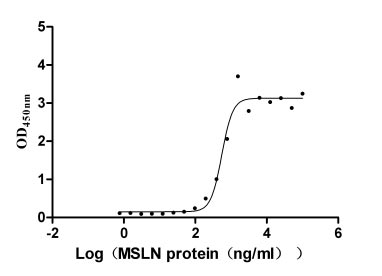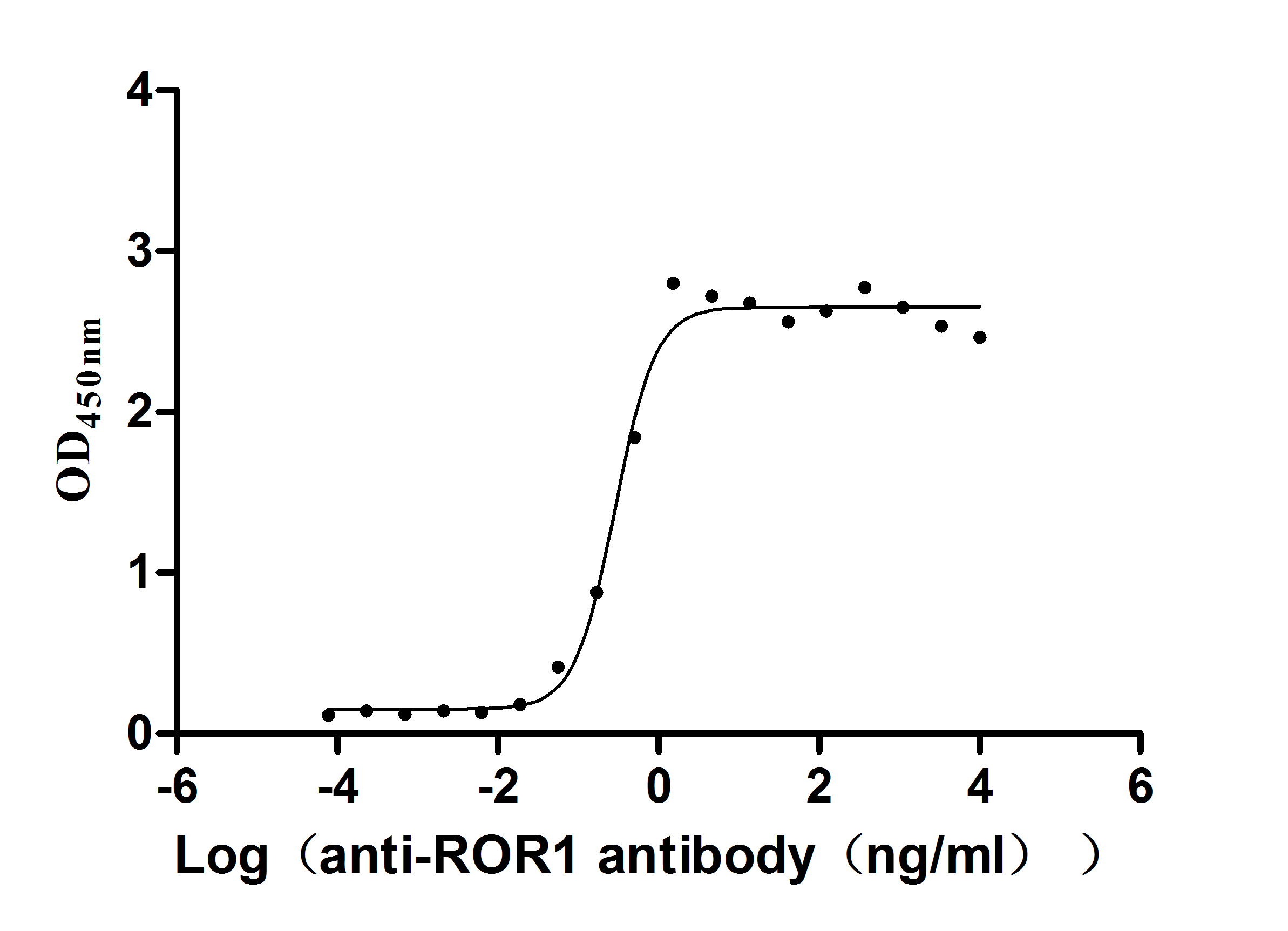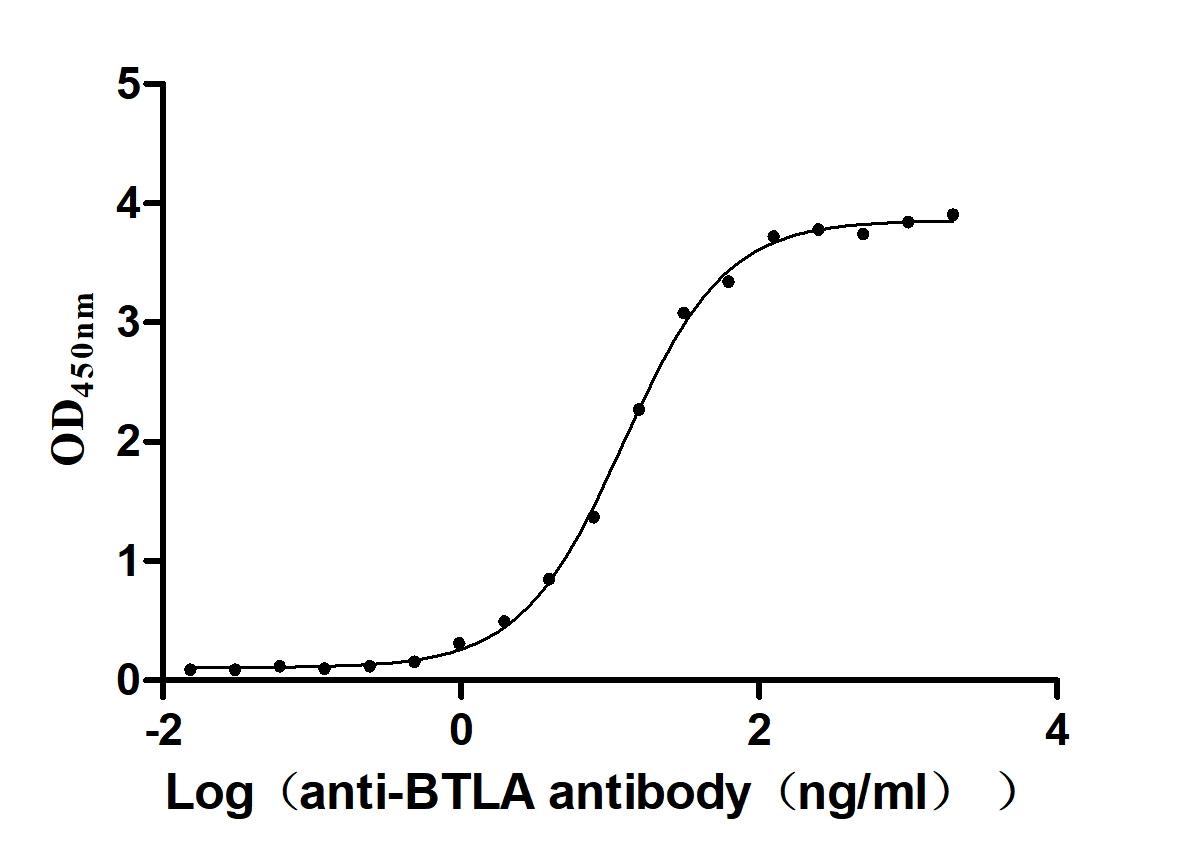Recombinant Rat Beta-arrestin-1 (Arrb1)
-
货号:CSB-YP002134RA
-
规格:
-
来源:Yeast
-
其他:
-
货号:CSB-EP002134RA
-
规格:
-
来源:E.coli
-
其他:
-
货号:CSB-EP002134RA-B
-
规格:
-
来源:E.coli
-
共轭:Avi-tag Biotinylated
E. coli biotin ligase (BirA) is highly specific in covalently attaching biotin to the 15 amino acid AviTag peptide. This recombinant protein was biotinylated in vivo by AviTag-BirA technology, which method is BriA catalyzes amide linkage between the biotin and the specific lysine of the AviTag.
-
其他:
-
货号:CSB-BP002134RA
-
规格:
-
来源:Baculovirus
-
其他:
-
货号:CSB-MP002134RA
-
规格:
-
来源:Mammalian cell
-
其他:
产品详情
-
纯度:>85% (SDS-PAGE)
-
基因名:
-
Uniprot No.:
-
别名:Arrb1; Beta-arrestin-1; Arrestin beta-1
-
种属:Rattus norvegicus (Rat)
-
蛋白长度:full length protein
-
表达区域:1-418
-
氨基酸序列MGDKGTRVFK KASPNGKLTV YLGKRDFVDH IDLVDPVDGV VLVDPEYLKE RRVYVTLTCA FRYGREDLDV LGLTFRKDLF VANVQSFPPA PEDKKPLTRL QERLIKKLGE HAYPFTFEIP PNLPCSVTLQ PGPEDTGKAC GVDYEVKAFC AENLEEKIHK RNSVRLVIRK VQYAPERPGP QPTAETTRQF LMSDKPLHLE ASLDKEIYYH GEPISVNVHV TNNTNKTVKK IKISVRQYAD ICLFNTAQYK CPVAMEEADD TVAPSSTFCK VYTLTPFLAN NREKRGLALD GKLKHEDTNL ASSTLLREGA NREILGIIVS YKVKVKLVVS RGGLLGDLAS SDVAVELPFT LMHPKPKEEP PHREVPESET PVDTNLIELD TNDDDIVFED FARQRLKGMK DDKDEEDDGT GSPHLNNR
-
蛋白标签:Tag type will be determined during the manufacturing process.
The tag type will be determined during production process. If you have specified tag type, please tell us and we will develop the specified tag preferentially. -
产品提供形式:Lyophilized powder
Note: We will preferentially ship the format that we have in stock, however, if you have any special requirement for the format, please remark your requirement when placing the order, we will prepare according to your demand. -
复溶:We recommend that this vial be briefly centrifuged prior to opening to bring the contents to the bottom. Please reconstitute protein in deionized sterile water to a concentration of 0.1-1.0 mg/mL.We recommend to add 5-50% of glycerol (final concentration) and aliquot for long-term storage at -20℃/-80℃. Our default final concentration of glycerol is 50%. Customers could use it as reference.
-
储存条件:Store at -20°C/-80°C upon receipt, aliquoting is necessary for mutiple use. Avoid repeated freeze-thaw cycles.
-
保质期:The shelf life is related to many factors, storage state, buffer ingredients, storage temperature and the stability of the protein itself.
Generally, the shelf life of liquid form is 6 months at -20°C/-80°C. The shelf life of lyophilized form is 12 months at -20°C/-80°C. -
货期:Delivery time may differ from different purchasing way or location, please kindly consult your local distributors for specific delivery time.Note: All of our proteins are default shipped with normal blue ice packs, if you request to ship with dry ice, please communicate with us in advance and extra fees will be charged.
-
注意事项:Repeated freezing and thawing is not recommended. Store working aliquots at 4°C for up to one week.
-
Datasheet :Please contact us to get it.
靶点详情
-
功能:Functions in regulating agonist-mediated G-protein coupled receptor (GPCR) signaling by mediating both receptor desensitization and resensitization processes. During homologous desensitization, beta-arrestins bind to the GPRK-phosphorylated receptor and sterically preclude its coupling to the cognate G-protein; the binding appears to require additional receptor determinants exposed only in the active receptor conformation. The beta-arrestins target many receptors for internalization by acting as endocytic adapters (CLASPs, clathrin-associated sorting proteins) and recruiting the GPRCs to the adapter protein 2 complex 2 (AP-2) in clathrin-coated pits (CCPs). However, the extent of beta-arrestin involvement appears to vary significantly depending on the receptor, agonist and cell type. Internalized arrestin-receptor complexes traffic to intracellular endosomes, where they remain uncoupled from G-proteins. Two different modes of arrestin-mediated internalization occur. Class A receptors, like ADRB2, OPRM1, ENDRA, D1AR and ADRA1B dissociate from beta-arrestin at or near the plasma membrane and undergo rapid recycling. Class B receptors, like AVPR2, AGTR1, NTSR1, TRHR and TACR1 internalize as a complex with arrestin and traffic with it to endosomal vesicles, presumably as desensitized receptors, for extended periods of time. Receptor resensitization then requires that receptor-bound arrestin is removed so that the receptor can be dephosphorylated and returned to the plasma membrane. Involved in internalization of P2RY4 and UTP-stimulated internalization of P2RY2. Involved in phosphorylation-dependent internalization of OPRD1 ands subsequent recycling. Involved in the degradation of cAMP by recruiting cAMP phosphodiesterases to ligand-activated receptors. Beta-arrestins function as multivalent adapter proteins that can switch the GPCR from a G-protein signaling mode that transmits short-lived signals from the plasma membrane via small molecule second messengers and ion channels to a beta-arrestin signaling mode that transmits a distinct set of signals that are initiated as the receptor internalizes and transits the intracellular compartment. Acts as signaling scaffold for MAPK pathways such as MAPK1/3 (ERK1/2). ERK1/2 activated by the beta-arrestin scaffold is largely excluded from the nucleus and confined to cytoplasmic locations such as endocytic vesicles, also called beta-arrestin signalosomes. Recruits c-Src/SRC to ADRB2 resulting in ERK activation. GPCRs for which the beta-arrestin-mediated signaling relies on both ARRB1 and ARRB2 (codependent regulation) include ADRB2, F2RL1 and PTH1R. For some GPCRs the beta-arrestin-mediated signaling relies on either ARRB1 or ARRB2 and is inhibited by the other respective beta-arrestin form (reciprocal regulation). Inhibits ERK1/2 signaling in AGTR1- and AVPR2-mediated activation (reciprocal regulation). Is required for SP-stimulated endocytosis of NK1R and recruits c-Src/SRC to internalized NK1R resulting in ERK1/2 activation, which is required for the antiapoptotic effects of SP. Is involved in proteinase-activated F2RL1-mediated ERK activity. Acts as signaling scaffold for the AKT1 pathway. Is involved in alpha-thrombin-stimulated AKT1 signaling. Is involved in IGF1-stimulated AKT1 signaling leading to increased protection from apoptosis. Involved in activation of the p38 MAPK signaling pathway and in actin bundle formation. Involved in F2RL1-mediated cytoskeletal rearrangement and chemotaxis. Involved in AGTR1-mediated stress fiber formation by acting together with GNAQ to activate RHOA. Appears to function as signaling scaffold involved in regulation of MIP-1-beta-stimulated CCR5-dependent chemotaxis. Involved in attenuation of NF-kappa-B-dependent transcription in response to GPCR or cytokine stimulation by interacting with and stabilizing CHUK. May serve as nuclear messenger for GPCRs. Involved in OPRD1-stimulated transcriptional regulation by translocating to CDKN1B and FOS promoter regions and recruiting EP300 resulting in acetylation of histone H4. Involved in regulation of LEF1 transcriptional activity via interaction with DVL1 and/or DVL2 Also involved in regulation of receptors other than GPCRs. Involved in Toll-like receptor and IL-1 receptor signaling through the interaction with TRAF6 which prevents TRAF6 autoubiquitination and oligomerization required for activation of NF-kappa-B and JUN. Binds phosphoinositides. Binds inositolhexakisphosphate (InsP6). Involved in IL8-mediated granule release in neutrophils. Required for atypical chemokine receptor ACKR2-induced RAC1-LIMK1-PAK1-dependent phosphorylation of cofilin (CFL1) and for the up-regulation of ACKR2 from endosomal compartment to cell membrane, increasing its efficiency in chemokine uptake and degradation. Involved in the internalization of the atypical chemokine receptor ACKR3. Negatively regulates the NOTCH signaling pathway by mediating the ubiquitination and degradation of NOTCH1 by ITCH. Participates in the recruitment of the ubiquitin-protein ligase to the receptor.
-
基因功能参考文献:
- Tyrosine hydroxylase upregulate beta-arrestin-1 in astrocytes to facilitate endocytosis of beta2-AR, required for endosomal ERK activation to drive the differentiation process. PMID: 26399643
- Results suggested that beta-arr1 and 2 may differently modulate mGluR7 signaling in developmental sevoflurane neurotoxicity PMID: 26621121
- Microinfusions of Arrb1 antisense oligodeoxynucleotides into female rat hypothalamus knocked down Arrb1 and prevented estradiol benzoate-induced lordosis behavior. PMID: 25803606
- The studies reveal how CB1 receptor activation translates into beta-arrestin 1/ beta-arrestin 2 signaling and identify a mechanism to control this pathway. PMID: 25081814
- oxymatrine can attenuate the development of UC by regulating the DOR-beta-arrestin1-Bcl-2 signal transduction pathway. PMID: 25480575
- The conformational differences between beta-arrestin1 and beta-arrestin2 in both the basal and pre-activated states might determine their different receptor selectivities and different cellular functions. PMID: 25542150
- Arrestins coordinate AT1 receptor regulation of ERK1/2 and Akt activity and stimulate protein translation via both Akt-mTOR-p70/85S6K and ERK1/2-p90RSK pathways. PMID: 25081544
- crystal structure of beta-arrestin-1 (also called arrestin-2) in complex with a fully phosphorylated 29-amino-acid carboxy-terminal peptide derived from the human V2 vasopressin receptor (V2Rpp) PMID: 23604254
- The interaction of beta-arrestin-1 with G-alpha-s regulates the activity of G-alpha-s. PMID: 23353685
- Suggest that following antidepressant treatment, beta-arrestin1 generates a transcription complex involving CREB essential for GDNF expression and release. PMID: 21223624
- Inhibition of adrenal beta arrestin 1 (betaarr1), either directly or by treatment to prevent receptor-betaarr1 coupling, might be of therapeutic value for curbing heart failure-exacerbating hyperaldosteronism. PMID: 21232674
- beta-Arrestin 1 interacts with, and acts as an adaptor for AIP4, an E3 ubiquitin ligase responsible for TRPV4 ubiquitination. PMID: 20650893
- Treatment of Rat-1 cells for 12 h with insulin induces an approximately 50% decrease in cellular beta-arrestin-1 content due to ubiquitination of beta-arrestin-1 and proteosome-mediated degradation. PMID: 12167719
- by recruiting phosphodiesterase to activated beta2-adrenergic receptors in the plasma membrane, beta arrestins target cAMP degradation to sites of localized PKA activity at the plasma membrane PMID: 12399592
- beta-arrestin is directly involved in glutamate-stimulated MAP kinase activation by acting as a signaling molecule. PMID: 12519791
- Replacement of intracellular loop 3 and the COOH tail of the NK1R with comparable domains of the NK3R diminished colocalization of the NK1R with beta-arrestin 1 and accelerated resensitization to that of the NK3R. PMID: 12958028
- betaArr1 may be involved in modulation of specific tactile stimulation from the skin in addition to nociception. PMID: 14519533
- beta-arrestin-1 expression is increased after cerebral hypoxia/ischemia. PMID: 15017017
- NF-kappaB activation and Ca2+/calcineurin signaling have roles in platelet-activating factor-induced chemokine gene expression and are inhibited by receptor phosphorylation and beta-arrestin recruitment PMID: 15308653
- Data suggest that beta-arrestin-1 can alter insulin signaling by inhibiting insulin-induced proteasomal degradation of insulin receptor substrate 1. PMID: 15456867
- phosphorylation-independent mechanisms regulate beta-arrestin association and internalization of BLT1 PMID: 15561704
- beta-arrestin2 utilizes mu-adaptin as an endocytic partner; the inability of beta-arrestin1 to sustain a similar degree of interaction with mu-adaptin may result from coordination of Tyr-54 by neighboring residues or its modification by Src kinase PMID: 17456469
- the "receptor-bound" conformations of beta-arrestins1 and 2 are different PMID: 17513300
- beta-arrestins regulate protein synthesis PMID: 18276584
- These studies indicate that beta-arrestin-1 plays a role in GLP-1 signaling leading to insulin secretion, defining a previously undescribed mechanism for GLP-1 action. PMID: 18445652
- beta-arrestin cleavage upon AT(1)R stimulation is a part of the unraveling beta-arrestin-mediated G protein-coupled receptor signaling diversity PMID: 18505723
- These findings demonstrate differences in internalization between the alpha1a- and alpha1b-AR and provide evidence that the lack of significant endocytosis of the alpha1a-AR is linked to its poor interaction with beta-arrestins as well as with AP50. PMID: 18523139
- a novel signaling pathway underlying this AT(1)R-dependent aldosterone production mediated by beta-arrestin-1 PMID: 19289825
- results demonstrate that 17-beta-Estradiol -mediated neuroprotection and ERK activation involve ERalpha activation of G-protein- and beta-arrestin-mediated mechanisms PMID: 19339617
显示更多
收起更多
-
亚细胞定位:Cytoplasm. Nucleus. Cell membrane. Membrane, clathrin-coated pit. Cell projection, pseudopodium. Cytoplasmic vesicle.
-
蛋白家族:Arrestin family
-
组织特异性:Predominantly localized in neuronal tissues and in the spleen.
-
数据库链接:
KEGG: rno:25387
STRING: 10116.ENSRNOP00000046069
UniGene: Rn.34876
Most popular with customers
-
Recombinant Human Macrophage migration inhibitory factor (MIF) (Active)
Express system: Mammalian cell
Species: Homo sapiens (Human)
-
Recombinant Human Mucin-16 (MUC16), partial (Active)
Express system: Mammalian cell
Species: Homo sapiens (Human)
-
Recombinant Human Heat-stable enterotoxin receptor (GUCY2C), partial (Active)
Express system: Mammalian cell
Species: Homo sapiens (Human)
-
Express system: Mammalian cell
Species: Homo sapiens (Human)
-
Recombinant Macaca fascicularis zymogen granule protein 16 homolog B (ZG16B) (Active)
Express system: Mammalian cell
Species: Macaca fascicularis (Crab-eating macaque) (Cynomolgus monkey)
-
Recombinant Human B- and T-lymphocyte attenuator(BTLA), partial (Active)
Express system: Mammalian cell
Species: Homo sapiens (Human)
-
Recombinant Human Dipeptidase 3(DPEP3), partial (Active)
Express system: Mammalian cell
Species: Homo sapiens (Human)
-




















